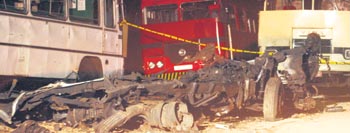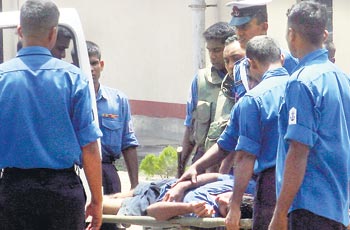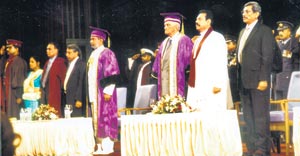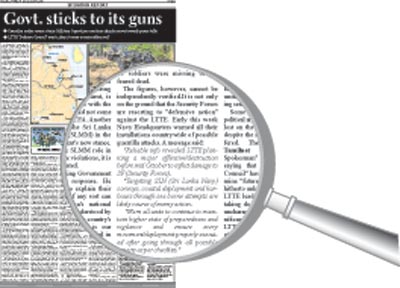
| Real heroes and mock heroics
Hardly had the nation recovered from the devastating debacle in the battlefields of Muhamalai on October 11. From the puny and the poor to the high and the mighty in the land reacted with shock and awe at the deaths of more than 138 brave officers and men of the Army. If their supreme sacrifice came as a sad loss to their families and friends, they were pained by those injured. The latest computation of figures placed the injured at over 600. And, last Monday, just four days after this debacle, the nation was numbed by another. Unbelievable but true. At least 116 Navy sailors were killed. The bodies of 90 were identified. More than 130 were injured. Of this number, 110 are still in hospital. This was at Boraluwala, Digampathana near Dambulla. Such a heavy death toll and casualty count would have been impossible if Tiger guerrillas were to fight ten different sea battles. But it came on land. It took only one suicide cadre and a truck load of explosives to cause that devastation. That too in a Government-controlled area considered safe and secure. A nation prepared for more funerals or the last rites of those who died. It was in all parts of the country. Now it was more than 253 in the Army and the Navy. Just a day later, Tiger guerrilla suicide cadres launched an attack on the Navy's SLNS Dakshina, their detachment in Galle.
It came in broad daylight, despite credible warnings the previous night. Ironic enough such warnings had been initiated by President Mahinda Rajapaksa, Minister of Defence and Commander-in-Chief of the Armed Forces. He received a tip-off. Thirteeen sailors and eight civilians were injured. A sailor and a civilian died later. An Inshore Patrol Craft (IPC), a coastal patrol boat, a Dvora Fast Attack Craft (FAC) and the non operational sub chaser SLNS Parakrama were damaged. Two oil tanks and two buildings were also damaged. The Navy claimed they had killed 15 guerrillas. Only three bodies of suspected guerrillas washed ashore near the naval establishment. Even if the attackers failed to cause heavy casualties or damage, the LTTE delivered a message - it still retained the military capability to reach the south. That message raised some concerns worldwide, particularly in foreign offices in countries where their nationals travelled to Sri Lanka, the tourism and travel trade. It also led to the cancellation of a US Marines-Sri Lankan Security Forces joint training exercise in the southern coast stretching from Hambantota to Tangalle. There were worries about force protection levels. This was at a time when small, ill-informed sections of the military establishment had, like in the past, continued to under estimate the enemy capability. They had concluded that the guerrillas have been almost defeated. Saying this is by no means to boost the morale of the Liberation Tigers of Tamil Eelam (LTTE), as some misguided men in uniform think or want Sri Lankans and the outside world to believe. They accuse the media when this harsh ground reality is repeatedly pointed out only to hide their omissions and commissions. When an enemy is underestimated, one need not be a Lieutenant General to say that the response to them is also an underestimated one.
Those pen pushers, anchor persons, those sitting in front of TV consoles or microphones at broadcast stations do not prosecute a war. They are not even allowed nearer the battlefield except on conducted tours. They only report, some on the basis of information dished out to them by spokespersons in Colombo and others from sources they deem credible. But there are those who hide their military blunders that not only boost the morale of their enemy, but also embarrass a Government and the people who look to them with great confidence. They are found out only when the media exposes such blunders in the national interest. They cannot be brushed under the carpet. Carl von Clausewitz in his treatise On War (1832) says "war is not merely a political act, but also a real political instrument, a continuation of political commerce, a carrying out of the same by other means…." During more than two decades of separatist War, there have been occasions when The Sunday Times exposed military blunders that cost lives and led to the loss of millions of rupees worth of equipment. This helped political leaders to understand realities. When they were told that artillery guns were destroyed (together with huge quantities of ammunition), it came to light the enemy had seized them. When they were told that battle tanks were destroyed, it came to light they were not. In the past at least one tank fell into the hands of the guerrillas. In Muhamalai five were lost. Besides the two destroyed, what happened to the other three? It is known that one is already in guerrilla hands. What has been paid for with the tax payer's money came to be used against the troops defending the nation's sovereignty and territorial integrity. Can anyone say this is the result of good planning?
One such blunder revealed exclusively by The Sunday Times (Situation Report) was the Army's debacle in Pooneryn on November 11, 1993. Consequent to a string of exposures thereafter, on December 31, 1993, then Commander of the Army Lt. Gen. Cecil Waidyaratne resigned. In his letter to late President J.R. Jayewardene he said "I sacrificed a very prestigious and distinguished appointment as Commander of the Army for the failure and negligence of others, in keeping with the highest traditions and ethics of a good soldier. I hope all this would not be in vain for if those officers found guilty are not removed and disciplined, it is the brave soldiers who are facing the brunt of the battle in the frontlines who could be deprived of leadership at this critical hour of our nation." Sri Lanka, with a one of the highest literacy rates in Asia, is perhaps one country in the world where the word "accountability" is increasingly getting confined to the dictionary. The media, among all others, are blamed. Not those who cause it, hide behind spokespersons and press releases to accuse others of treachery and boosting the morale of the LTTE to cover up their battlefield reversals. More comments on that later. Sailors boarding 12 buses at the Navy's Eastern Naval Area Headquarters in Trincomalee were unaware of what was awaiting them. Around 10.30 a.m. the convoy set out. Each bus kept a distance of 100 metres from the other. Armed sailors in Double Cabs were escorting them. Motor cycle outriders travelling ahead ordered traffic along the road to move to a side as the lengthy convoy whizzed past at some 60 miles per hour.
Before boarding the buses, the Navy personnel who were returning to their homes on leave, surrendered their National Identity Cards to obtain a weapon, body armour and helmet. This is to be on the ready if they encountered a surprise attack before they reached their transit point. They hand them over to their colleagues returning after leave. On the same day, around 7.30 a.m. sailors in three buses left the SLNS Rangala base in Colombo. Along the way, they stopped at various points to pick colleagues who were returning after leave. The naval troops travelling from the two directions met at three different pre-arranged locations. The most used was the transit point at Boraluwala, Digampathana, near Habarana. It was past 12.30 p.m. when the parties arrived. It was routine for them to converge to listen to a briefing by an officer. This was to keep the men who were going towards Trincomalee alert. Those travelling on leave were also told of procedures. It was only thereafter that the ritual of surrendering their weapon, body armour and helmet began. Only then, would they secure their identity cards and board another bus to return to their abodes. Just after 1.30 p.m. before all this could happen, disaster struck. The truck coming from the direction of Dambulla drove towards the transit point. As it neared, the driver, a suicide bomber in a black T-shirt shouted, "break nehe, brake nehe (no brakes, no brakes), rammed on to a bus and crashed into the crowd. A thundering explosion rent the air. Sailors dropped dead or were injured. Only the chassis and the engine of the lorry remained. The Isuzu half lorry has been registered in the name of a person living in Meetotamulla, Wellampitiya. The area came to be called Boraluwala after contractors removed gravel from this area to fill land. Within minutes, the news spread countrywide. That was to lead to emotional scenes at Boraluwala as villagers rushed in to help. Mobile phones strewn all over began to ring. None was answered and soon the chorus of ringing tones grew. There were also several that recorded short messages. One had 47, all asking a sailor whether he was safe. He lay dead. Twenty buses and a lorry were damaged. Bodies lay strewn all over. Identification became difficult since many did not possess their National Indentity Cards. Shocking enough, the subject of a possible attack on the transit camp was known, known well ahead, since there were warnings just days earlier. Yet, the precious lives of those men, who were not in battle, but were either going to see their loved ones or returning after seeing them, had to die. The tragic irony of this was underscored once more a day later. On Wednesday morning, Tiger guerrillas attacked SLNS Dakshina in Galle. It was only on Tuesday night that both the Police and the Navy were warned of guerrilla boat movements. Reports spoke of boats leaving Panama, south of Pottuvil, heading towards Galle that night. The attackers came in as fishermen mingling with other boats around. Though an alert was in place, it had been lifted by morning. Four boatloads of guerrillas were involved in the attack. On October 8, 2006 The Sunday Times (Situation Report) revealed exclusively how Navy Headquarters issued a warning to all its establishments. It said, "Reliable info revealed LTTE planning a major offensive/destruction before mid October to inflict damage to SF (Security Forces). "Targeting SLN (Sri Lanka Navy) convoys, coastal deployment and harbours through sea borne attempts are likely course of enemy action. "Warn all units to continue to maintain higher state of preparedness and vigilance and ensure every movement / deployment properly executed after going through all possible aspects as per checklist." This warning from Navy Headquarters to their establishments countrywide was sent on October 3, just 11 days before the Habarana incident and 13 days before Galle. Were they, like other intelligence warnings, ignored? What is the purpose of providing a checklist if it is not followed? Didn't such neglect lead to the deaths of 116 sailors and injuries to others? Like the Muhamalai blunder, who are accountable for this? Navy Headquarters is conducting a top level investigation into the two incidents. In respect of Galle, the Southern Naval Area Commander and the Commanding Officer of the SLNS Dakshina have already been moved out of their stations. With regard to the Muhamalai debacle, members of the National Security Council on Thursday heard three Brigade Commanders explain what happened. They were inducted to the NSC by a top Army official. Their revelations left no doubt in the minds of participants that the military action was not only ill planned but poorly co-ordinated. Yet, some Army top brass are taking exception to some of the issues raised in The Sunday Times. Efforts have been made by them to suggest through Rupavahini, the national television network in their Sinhala news bulletin on Friday night that the action was not ill planned and that some of the media reportage was boosting the morale of the LTTE. Though The Sunday Times (Situation Report) was not mentioned the references were to its contents. This report was, however, stopped by top Government leaders from being broadcast in the English news bulletin later that night. Evidently, it was not the Government's official view. Now an inquiry is under way to ascertain how it originated. It was only some three weeks ago, Chief of Defence Staff Air Chief Marshal Donald Perera thanked the Sri Lankan media for the full support given to the Security Forces in their counter terrorism efforts. In the national interest and for the benefit of thousands of dedicated troops in the battlefront, who are courageously risking their life and limb, the issues raised merit answer. It will thus show that some are trying to hide behind the truth and hurl abuse only to cover their own misdeeds. Here are a few instances: The offensive, or "confrontation" at Muhamalai, as they prefer to call it, they insist, was not "ill planned." How come more than 138 brave officers and soldiers paid the supreme sacrifice with their lives? How come more than 483 other officers and men were injured? These were figures disclosed by the Media Centre for National Security (MCNS). Of the injured, it was pointed out that 283 were P 1 or P 2 cases. They were of a serious nature. Ask any one of the injured who are on their sick beds whether it was "ill planned" or "well planned." They will provide the answers to what some want to hide. Even the most dim witted would concede that the loss of a large number of lives not to mention battle tanks, armoured personnel carriers and other military hardware, was not well planned. I spoke with some officers engaged in the offensive. They said there was a lack of understanding of enemy positions, their defences or battle plans. There were no plans to deal with casualties, as a high rate was not anticipated. The battle tanks got bogged down due to soggy terrain caused by rains. Thus, the infantry found it difficult to hold their ground and in fact they were trapped. Could all this happen if there was good planning? It is claimed that the contents of The Sunday Times (Situation Report) account could be a move to cause rift and tarnish the image of senior officers. It is a public secret, known by both Sri Lankans and those abroad, widely reported and editorialized in the local media, that some senior officers had developed serious rifts with others over their greed in claiming greater shares of military successes. This has reached worrisome proportions that dialogue between some at the highest levels has ceased. This was the rationale, though ill conceived, behind the Ministry of Defence move to ask the media to verify all their reports with the MCNS. They sought to strike a balance. The claim that the account boosted the morale of the LTTE and tended to lower the morale of the Security Forces is laughable. It is no secret that the morale of the soldier is very often affected when battlefield debacles occur. This is when they are ill planned and lead to heavy casualties. It is they who come to know it first. The news of such debacles soon spread among officers and men. They speak of someone somewhere having blundered, and blundered colossally. And such actions no doubt boost the morale of the LTTE. That is without question. It also deprives a Government the position of strength it had developed during one military success after another. It also places the Government in bad light in the eyes of the international community. Equally importantly, it demoralizes the public. To blame it on the media is one thing. But it is much worse when the truth is kept away and accusations are made on those who want to reveal them in the national interest. This is why some "super heroes," propelled by the unbridled power they wield, choose to call them traitors. This is nothing new. The truth hurts them. Such reportage is not in line with accounts they doctor and engineer with "friendly" media outlets. All this boils down to a question of leadership. Last Thursday, President Mahinda Rajapaksa, who addressed the convocation of the Kotalawala Defence Academy quoted the Austrian author of management related literature, Peter Ferdinand Drucker's words. He said, "Effective leadership is not about making speeches or being liked. Leadership is defined by results not attributes." How true. These developments come in the backdrop of both the Government and the LTTE agreeing to resume peace talks on October 28 and 29. Yet, there is a hurdle to clear before the two sides meet in Geneva. That is the all important question of how the LTTE delegation will travel to Geneva. They have told the Norwegian facilitators of the need for special arrangements in the aftermath of what they call humiliating treatment received when they passed through Colombo on the last occasion. That was when they were returning from Geneva after refusing to meet a Sri Lankan delegation at peace talks. Their request was conveyed to Norway's special envoy for the peace process Jon Hanssen Bauer and Ambassador Hans Brattskar when they were in Kilinochchi last Thursday. The duo drove by road from Kilinochchi to Vavuniya to board an Air Force helicopter after their talks. During the flight the rotor blade hit a bird causing vibration. The pilot landed in Anuradhapura. Though a fixed wing aircraft was later lined up, there was bad weather. This forced the Norwegian duo to travel by road. It later turned out to be a diplomatic motorcade with Japan's special envoy Yasushi Akashi and the Swiss Ambassador to Sri Lanka, Ms. Ruth Slint, joining in. They happened to be in the sacred city. They arrived in Colombo close upon midnight. That led to the cancellation of a dinner planned by Government leaders for Mr. Hanssen Bauer on Thursday night. It was re-scheduled for Friday after Mr. Bauer and Mr. Brattskar delayed their departure. Though Mr. Bauer left early yesterday, Mr. Brattskar is still in Sri Lanka. He is expected to leave for Oslo after finalising with the Government the travel formalities for the LTTE delegation. Government leaders are learnt to be still locked in discussion over the issues connected with LTTE travel. The Government team is expected to leave on Wednesday while the LTTE group will travel on Tuesday. General Norman Schwarzkopf, who completed two tours of duty in Vietnam and gave leadership to the American troops in the Gulf War of 1991 once declared in his autobiography 'IT DOESN'T TAKE A HERO' that: "It doesn't take a hero to order men into battle. It takes a hero to be one of those men who goes into battle." The remarks reflect the humanity and humility of a five star General who commanded millions of troops and earned their respect. In Sri Lanka, the real heroes are those who paid with their lives and those who are now fighting to heal the wounds inflicted by the enemy. There is no doubt the nation salutes these true heroes for their sacrifice. Those men in the Army, Navy, Air Force, and Police (including the Special Task Force) have done their nation proud. |
||||||||
| || Front
Page | News
| Editorial
| Columns
| Sports
| Plus
| Financial
Times | International
| Mirror
| TV
Times | Funday
Times | |
| |
Copyright
2006 Wijeya
Newspapers Ltd.Colombo. Sri Lanka. |



